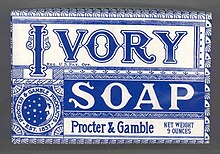If you don't want to be spoiled on what happens then just try the experiment first.
1. Take a bar of Ivory soap (make sure it is Ivory)
2. Unwrap the soap and place it on a paper plate
3. Put the soap and plate in the microwave for a minute and a half (1m:30s)
4. Observe (but also be careful when taking the plate out as it can be hot)
So.... what did you think? What happened?
Here is the spoiler! The video is not too great due to microwave screen, but the pictures show what happens too.
That's pretty amazing huh! Be careful the soap does get hot. Once it cools it will still work like soap so it is an easy way to make soap flakes.
There are some cool conversations that can come out of this experiment.
The first is about the microwave. A microwave heats sugar, water, and fats. So one of those must be pretty abundant in Ivory soap. The microwave itself has a pretty interesting story which I added below.
The other discussion is about Ivory soap and why it behaves this way in the microwave. A known fact about Ivory soap is that it floats in water. Ivory soap is "whipped" to introduce tiny air bubbles. Those air bubbles contain water and so that is the reason the soap expands so readily in the microwave.
Below are some fun facts about the microwave and Ivory soap taken from Wikipedia
Ivory Soap
Early days[edit]
In 1840 the J.B. Williams Company in Glastonbury, Connecticut, manufactured soap under the name Ivorine. Williams decided to focus on its shaving soap and sold Ivorine to Procter & Gamble, who later renamed it Ivory.[1]
1874 Procter & Gamble trademarks “Ivory,” the name of its new soap product. The name was created by Harley Procter, the founder’s son, who was inspired by Psalms 45:8 in the Bible: "All thy garments smell of myrrh, and aloes, and cassia, out of the ivory palaces whereby they have made thee glad."[2]
As Ivory is one of P&G's older products (first sold in 1879), P&G is sometimes called "Ivory Towers" and its factory and research center in St. Bernard, Ohio, is named "Ivorydale".[3]
Ivory's first slogan, "It Floats!", was introduced in 1891. The product's other well-known slogan, "9944⁄100% Pure" (in use by 1895), was based on the results of an analysis by an independent laboratory that Harley Procter, hired to demonstrate that Ivory was purer than the castile soap then available.[4]
Ivory bar soap is whipped with air in its production and floats in water. According to an apocryphal story, later discounted by the company, a worker accidentally left the mixing machine on too long and the company chose to sell the "ruined" batch, because the added air did not change the basic ingredients of the soap. When appreciative letters about the new, floating soap inundated the company, P&G ordered the extended mix time as a standard procedure. However, company records indicate that the design of Ivory did not come about by accident. In 2004, over 100 years later, the P&G company archivist Ed Rider found documentation that revealed that chemist James N. Gamble, son of the other founder, had discovered how to make the soap float and noted the result in his writings.[5]
1900's[edit]
In October 1992, Procter & Gamble market-tested a new Ivory formula, a "skin care bar" that would address customer complaints about dryness but would not float like the original.[6] In October 2001, P&G tested the sinking bar soap as part of an advertising campaign in the United States, in a six-month plan to release 1,051 soap bars that sink, among other bars that float, to see if people would notice the sinking bars, even if given a cash reward of up to $250,000.[7] The D. L. Blair company, part of Draft Worldwide, a unit of the Interpublic Group of Companies, was assigned to administer the contest.[7]
Percy Spencer - Inventor of the microwave:
One day while building magnetrons, Spencer was standing in front of an active radar set when he noticed the candy bar he had in his pocket had melted. Spencer was not the first to notice this phenomenon, but he was the first to investigate it. He decided to experiment using food, including popcorn kernels, which became the world’s first microwaved popcorn. In another experiment, an egg was placed in a tea kettle, and the magnetron was placed directly above it. The result was the egg exploding in the face of one of his co-workers, who was looking in the kettle to observe. Spencer then created the first true microwave oven by attaching a high density electromagnetic field generator to an enclosed metal box. The magnetron emitted microwaves into the metal box blocking any escape, allowing for controlled and safe experimentation. He then placed various food items in the box, while observing effects and monitoring temperatures.
Raytheon filed a patent on October 8, 1945 for a microwave cooking oven, eventually named the Radarange. In 1947, the first commercially produced microwave oven was about 6 feet tall, weighed about 750 lbs, and cost about 5,000 US$. In 1967 the first relatively affordable ($495) and reasonably sized (counter-top) microwave oven was available for sale.[2]



No comments:
Post a Comment